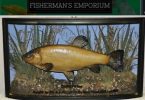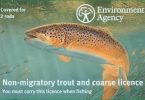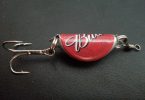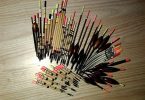Guidance notes prepared by
Dr Bruno Broughton B.Sc. (Hons), Ph.D., F.I.F.M., Fisheries Management Consultant
General Comments
Obviously, fish must eat to survive. If they consume more than their bodies need to simply ‘tick over’, this extra nutrition is available for growth, the production of eggs and milt, increased movement, etc. Because fish are so-called ‘cold-blooded’ animals, their body temperatures are more or less the same as the water surrounding them. Furthermore, the temperature of their environment governs their internal body processes – their metabolism. Thus, if water temperatures increase, their metabolism increases and they require more food.
Effects Of Baits On Fish
The metabolism of some British coarse fish is geared to water temperatures higher than those of this country. Everything else being equal, for example, common and mirror carp will grow fastest at water temperatures of 25-26°C, and maximum growth will continue for as long as the water temperature is at this sort of level. (This is the main reason why carp in western Europe, parts of North America and Africa grow larger than in this country – it’s hotter, for longer, than in Britain).
Most fish have a catholic diet which includes most forms of aquatic invertebrate animals, some plants and, occasionally, other material (e.g. fish fry, tadpoles). It has not been proven that they will actively select certain natural food items and ignore others, although this may occur. Usually, they appear to eat what is most readily available.
That said, their appetites certainly seem to be stimulated by certain tastes/smells. Even in the 1940s, American scientists discovered that one of the most successful flavours with which to lace poisoned maize (used to eradicate carp!) was synthetic maple.
That fish can be weaned onto non-natural food is well known. This may occur for non-angling reasons (e.g. the famous roach shoals at Cappoquin in Ireland which fed on blood and offal discharged into the river by an abattoir). When large quantities of anglers’ baits and free offerings are introduced, these items may be very important in the diet of fish. The best example is that of the River Severn barbel which, according to several scientific studies carried out in the 1970s, thrived on a diet comprising 50-60% anglers’ baits, mostly maggots.
There is a growing body of evidence that carp and other fish have benefited from the mass introduction of both particle (i.e. seed and nut) baits and ‘boilies’. Indeed, several of the boilie manufacturing companies also run carp fisheries where they deliberately feed the fish on miss-shapen boilies or ‘end-cuts’ of boilie paste from the boilie-making machines. I have yet see evidence that these fish have suffered any nutritional deficiencies. Indeed, the reverse is true: they seem to thrive on this diet.
The conclusion from these observations, and from numerous studies overseas on the diet of carp – notably in Israel, where they are grown for food – is that the type of boiled and particle baits used in Britain have had beneficial effects on carp growth and general health. Given that no-one actually force-feeds fish, they will stop feeding when they are full or have satisfied their hunger. This fact is used not only by anglers but also by some coarse fish farmers, who employ self-feeding ‘demand’ hoppers full of pelleted food to feed their fish. The fish release pellets by nudging a float-operated lever which opens the flap at the base of the hopper.
Two other points are worthy of note. Firstly, nuts and seeds should never be used uncooked, principally because they will absorb water and swell in the guts of fish once they have been swallowed. There is strong circumstantial evidence that this has caused the premature death of carp and other species at several fisheries. Soaking, then cooking these baits can overcome the problem. Peanuts should be of so-called ‘human grade’ which have been screened to ensure that they are not contaminated by aflatoxins – poisons released by fungi which can infect nuts and alleged to be responsible for severe or fatal liver damage to carp on some fisheries.
Secondly, I have come across several fishery owners who believe that so-called ‘shelf-life’ baits can cause carp to feed less often than one would expect. Although their theories have not been proven, they believe that the anti-bacterial treatments which prevent the baits decomposing before purchase may also (i) inhibit their breakdown on the bed of fisheries, and (ii) ‘knock-out’ bacteria in the guts of fish, thereby increasing the time it takes to digest the baits. I am not aware of any research which confirms (or refutes) these theories.
Effects Of Baits On Fisheries
When anglers’ baits are introduced but not eaten immediately by fish, they may remain intact for some time until they decompose slowly or are eaten by fish, water birds or invertebrate animals.
Although the ‘skinning’ of boilie baits or the use of bait-hardening ingredients renders them less susceptible to consumption by small fish and invertebrates, eventually they do break down sufficiently to enable these animals to eat them. This is true of most other baits, including groundbait. It would take the introduction of a very large number of baits to produce any form of pollution arising from the presence of uneaten baits on a lake bed.
In any event, the baits would all eventually disappear as they were eaten or rotted away.
In my opinion, it would take an unreasonably large number of baits to produce this alleged polluting effect and, in any event, they would all eventually disappear as they were eaten or decomposed naturally. On very small and heavily-fished waters, it is conceivable that this might produce a temporary but undesirable change in the water quality from which fish could not escape; on large waters, fish would undoubtedly simply avoid any pockets’ of pollution – their instinct to survive and their ability to avoid danger is far greater than their desire to feed.
Studies into groundbaiting on Welsh reservoirs and lakes have revealed that the potential input of phosphorous – the plant nutrient which stimulates ‘blooms’ of algae – is insignificant. Indeed, the phosphorous input from feeder streams, leaf litter and the waste products of water birds is of far greater importance to the nutrient ‘loading’ of these bodies of water.
Effects Of Baits On Fishing
There is no doubt that species other than carp learn to eat boilies and they, too, appear to benefit as a result. However, if the fish become really pre-occupied with these baits, they may start to ignore more conventional baits. There is some evidence that this has occurred on some ‘mixed’ fisheries, but similar allegations have been levelled at other types of bait – including bloodworm and joker, nuts, hemp, trout pellets, luncheon meat – and groundbait.
From the fishery management standpoint, the nub of the problem is whether or not to allow the unrestricted use of boilies/nuts and tolerate the risk of reduced catches of non-carp species, or to instigate some form of total or partial boilie ban.
Conclusions
Bait bans
On well-policed waters, it may be possible to impose bait bans successfully, although such moves tend to be very unpopular with carp anglers. However, there is a real temptation that carp anglers will continue to use the banned baits or bait-up surreptitiously and use something similar on the hook (such a~ a hard paste of similar size, shape, colour and flavour to that of boilies). This can lead to arguments with club bailiffs, problems at committee level and a split in the loyalties within a club between carp anglers and the rest. The alternative is for every angler to adopt a common sense policy to his or her fishing – by not baiting up excessively with boilies or any other bait, and by realising that other anglers are colleagues, not competitors!
Where such policies fail, the only other option is to develop carp fisheries for carp alone and to remove most or all of the carp from ‘mixed’ fisheries. This initiative is only available to clubs which control several fisheries and opt to develop one for carp alone. It allows carp anglers to use whatever bait they choose without detriment to the fishing for other species, which could be transferred to other non-carp waters.
Groundbait bans
On the vast majority of fisheries there is no logical justification to impose bans on the use of groundbait if it is used in moderation. On small, heavily-fished ponds and lakes, a limit on the quantity of groundbait allowed per angling session may be appropriate to ensure that anglers’ sport is not impacted adversely by uneaten bait left by previous anglers.
Further Reading
UWIST 1984.
Ground Baiting.
In: The Impact Of Anglers On Wildlife And Site Amenity, Chapter 3
(pages 145-155). Published by the Department of Applied Biology, The University Of Wales.
R W Edwards & M Cryer. 1985.
Angler litter.
In: Angling And Wildlife In Fresh Waters, edited by P S Maitland & A K Turner. (ITE Symposium No. 19.)
Published by the Institute of Terrestrial Ecology.
R W Edwards & V A Fouracre. 1983.
Is the banning of ground-baiting justified?
Proc. 3rd Brit. Freshw. Fish. Conf., 89-94.
Additional Advice
For more advice on this or other similar topics, contact me on:







